Serie A has just left matchday six, and the table is slowly but surely taking shape.
Cagliari Calcio, who have played five matches to date, are in need of some points, and quickly, as they’ve gone winless in those opening games.
They’ve conceded eight, which, for a team that finished one point above the relegation zone in Serie A last season and conceded 68 goals along the way, eight goals shipped in five games is not a reason to panic — it is certainly not the reason they find themselves rock bottom of Serie A in the early stages of the season.
Premier League winner Claudio Ranieri guided the club to safety last season in their first campaign back in the top flight, but new manager Davide Nicola tactics have yet to find the right formula to get his team firing on all cylinders.
According to data, Nicola has his Cagliari side playing aggressively out of possession.
In possession, they consistently move the ball forward and into the box—they just can’t seem to find that goalscoring touch.
This team analysis will provide a team-focused scout report and tactical analysis of Cagliari’s attacking problems — an insight into their tactics on the ball as we look to uncover just why they’re struggling so much in front of goal.
The analysis will also include a brief discussion surrounding their high-pressing tactics.
Davide Nicola Tactics – Lack Of Effective Attacking Support & Decision Making
As we mentioned in the intro, Cagliari Calcio have not struggled in terms of possession under Davide Nicola, when it comes to getting the ball forward or getting shots off on goal.
They rank highly for several attacking metrics that do provide hope for improvement in the near future, but there is more to their attacking problems than just bad luck in front of goal.
Part of their problem could be caused by the lack of goals itself—a potential psychological impact on the team that could impact their confidence in key moments.
Desperation could also sneak in as they try to get the team firing together.
Those psychological impacts could negatively affect Nicola’s attacking tactics because Cagliari’s build-up play is often to a good standard.
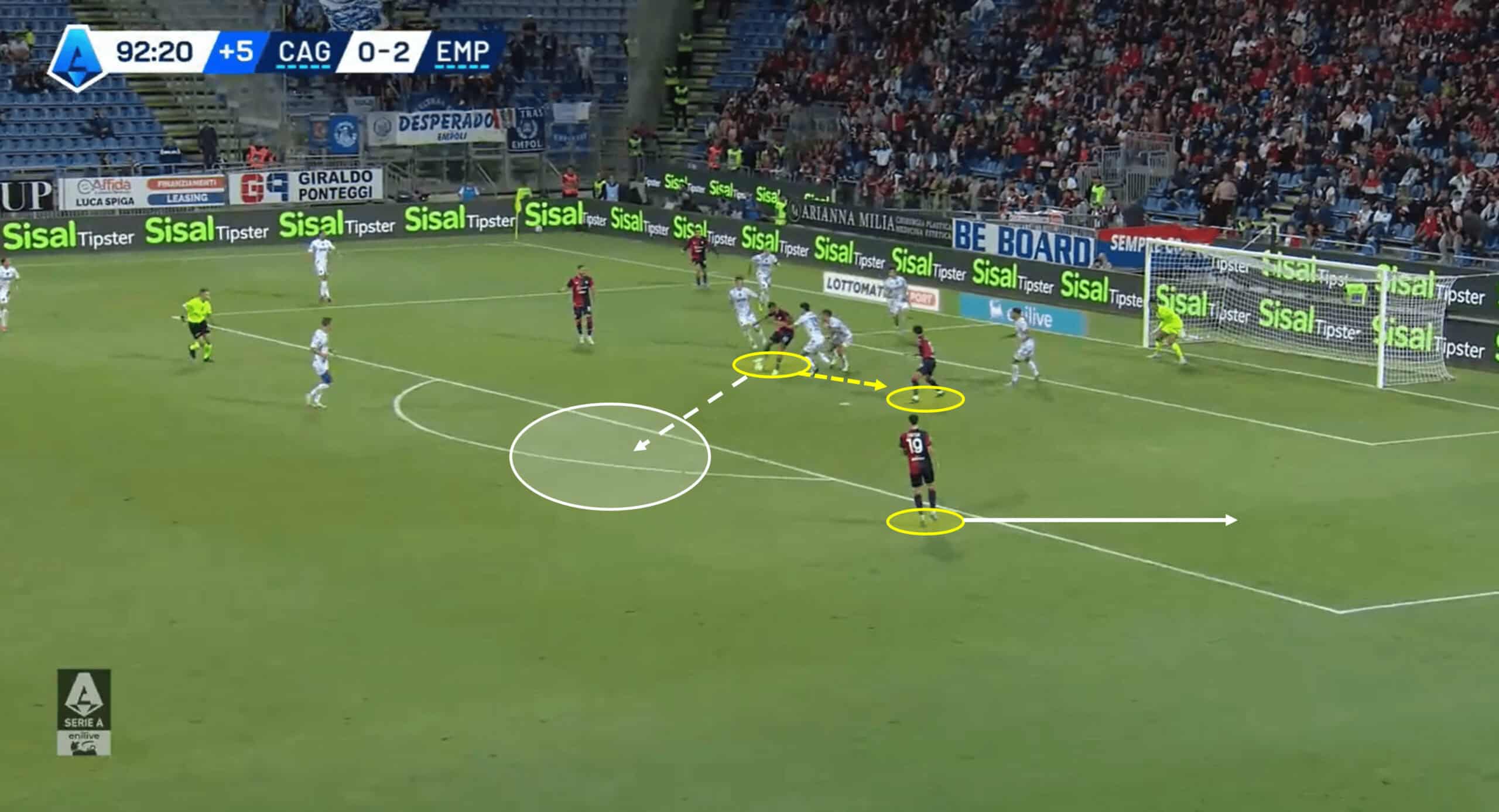
One tactical element that sometimes suffers due to the aforementioned reasons is a lack of proximity support around the edge of the box in key attacking moments, as shown in Figure 1 above.
After a clever, fast-paced move down the left flank, Cagliari did well to work the ball into the position in the image above, but a lack of support ultimately let down the attack.
Right wing-back Nadir Zortea is there to provide a wide option just outside the box.
However, the lack of an additional central option forces Zortea inside slightly, with the wing-back seemingly caught in two minds about his positioning.
If that central support was there at the edge of the box, Cagliari would’ve had the option to push Zortea into a broader, more dangerous supporting position, which in turn would stretch the opposition.
A strike from the edge of the box would’ve also become a viable option, but instead, a short pass into the next striker who could only snatch at the chance unfolded.
Multiple instances have been similar to this one and should be something that Nicola looks to fix quickly.
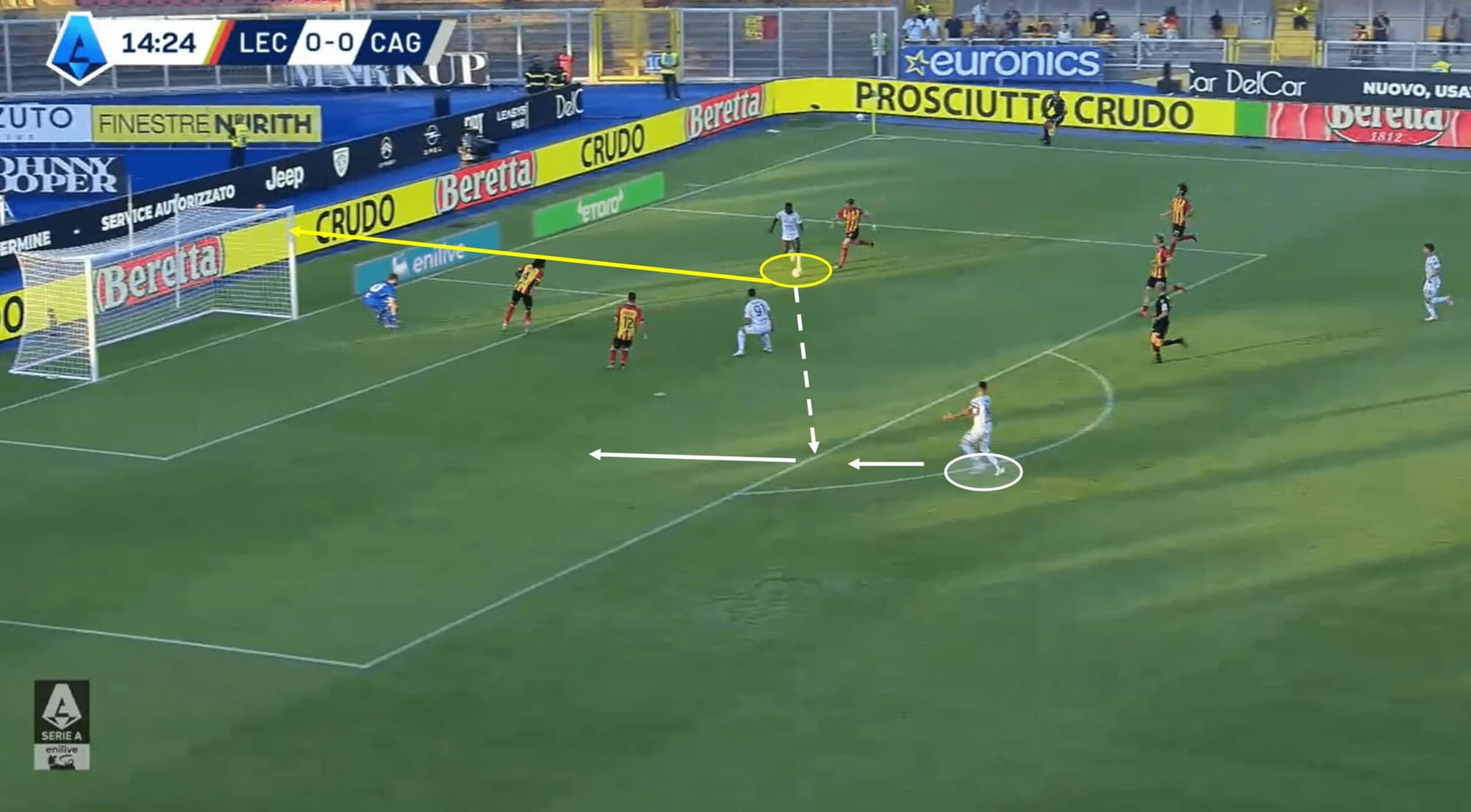
However, as shown in Figure 2, there are instances where late box support does arrive and is not used.
In fairness, as a striker in that position, the decision to take the shot on himself is understandable.
Still, from an analytical viewpoint, it is a tricky angle with both the defender and goalkeeper in the way, meaning that the strike would need to be of the highest quality to find the back of the net.
If he had just lifted his head slightly, he would’ve spotted the well-placed supporting midfielder arriving at the edge of the box, who had an incredible amount of space to run into, had he received the ball at all.
A constant with teams that are struggling to score goals is often poor decision-making—this is an example of that, and it could relate to the aforementioned desperation creeping in; a team high on confidence would’ve been more composed and effective in this scenario.
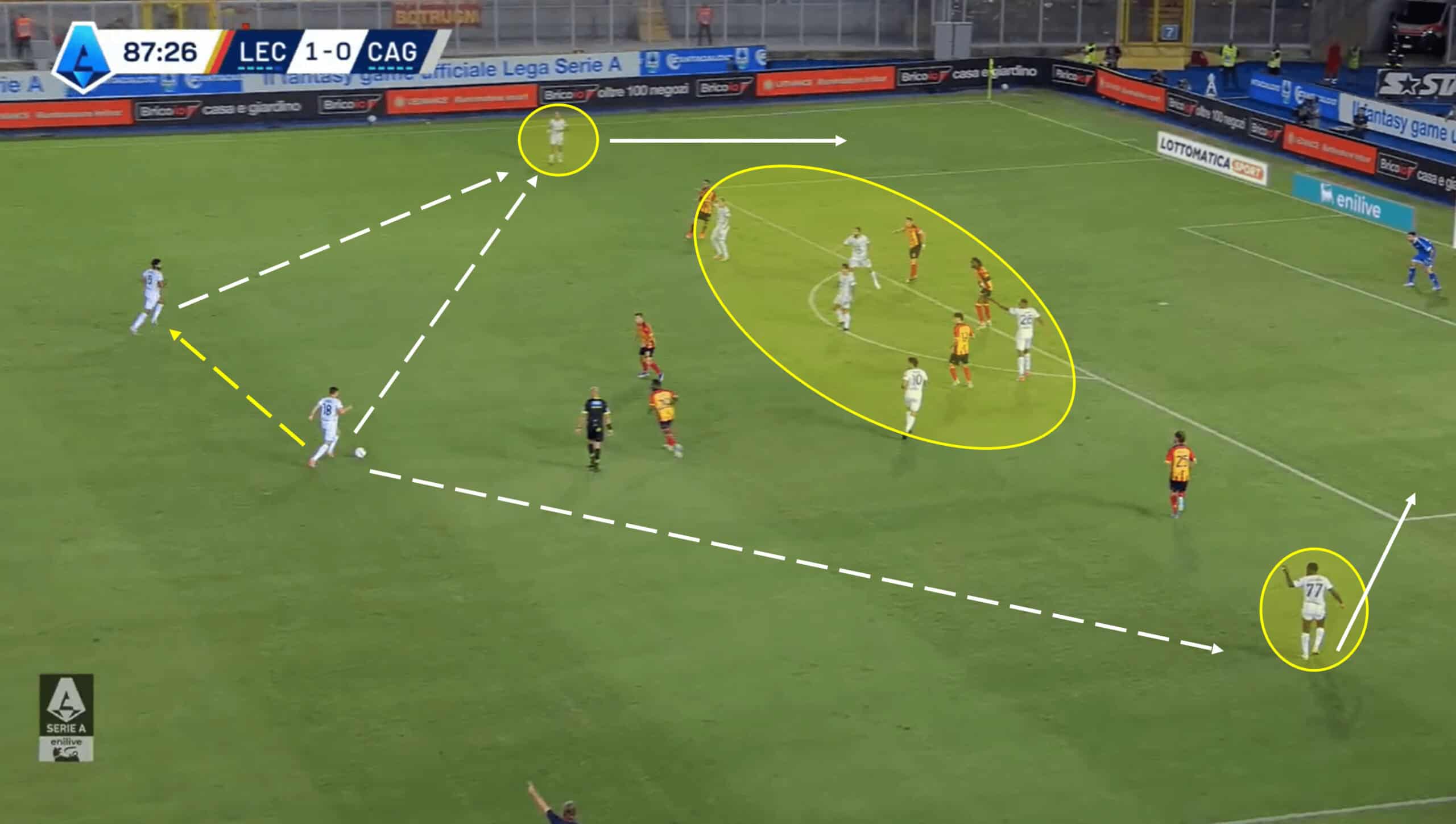
We mentioned that Cagliari’s build-up can be very effective at times, and that is true—a combination of good technical individual moments and a strong tactical foundation makes this possible.
However, it also requires patience and good decision-making, which, as with the previous example, let this chance down as well.
Figure 3 shows Cagliari looking to break down a Lecce low block (albeit against 10 men).
The block had a good shape, with both wide options and a strong central presence.
As with all analysis images in this article, the yellow lines represent what actually happened, while the white lines demonstrate what could’ve/should’ve happened if things had gone better for Cagliari.
As you can see, both wide players would’ve had the chance to receive the ball and engage in a 1v1 scenario against the opposition full-backs.
Success here would’ve enabled the wide men to deliver a cross into that strong central presence that outnumbers the Lecce defensive unit.
Cagliari had several avenues to explore in furthering this promising build-up phase late on, but instead, they resorted to an ambitious long-range effort that sailed over the crossbar—a true disappointment and a waste of a genuine attacking chance.
Again, is this a sign of that lack of confidence/patience and desperation playing a part?
Cagliari Quality Of Chances
Suppose you haven’t watched Cagliari this season or seen any of their attacking data apart from the one goal in five games stat.
In that case, you’d be forgiven for assuming they just struggle to carve out any opportunity on goal.
But that assumption would be far from reality.
At the time of writing, Cagliari averaged 13.25 shots per 90 – the third-highest number in Serie A.
They also have a total xG of 6.78, which is by no means a high number in comparison to the rest of Serie A, but it is an indication that they should have scored more than one goal.
Cagliari Shot Assists Map – Serie A 2024/2025
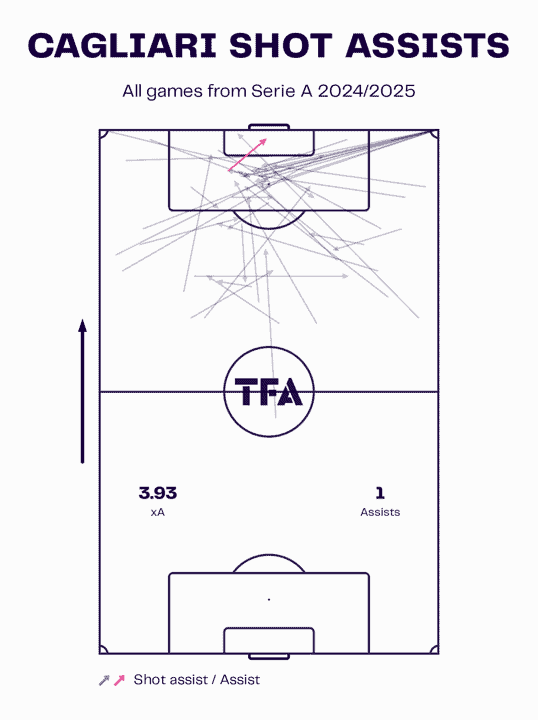
If we look into the location of shot assists, a couple of noteworthy elements jump out.
There are plenty of corners but no success – that’s one element.
And in fairness, on some occasions, Cagliari have simply been the victim of some fantastic goalkeeping – and that doesn’t just go for their shots from corners.
Cagliari Crossing Zones Map – Serie A 2024/2025
Another element worth discussing is their tendency to deliver crosses from deep areas on both flanks.
They are finding some success with these crosses, but they find even more success by varying their box deliveries, by crossing from the byline more often and more effectively, for example.
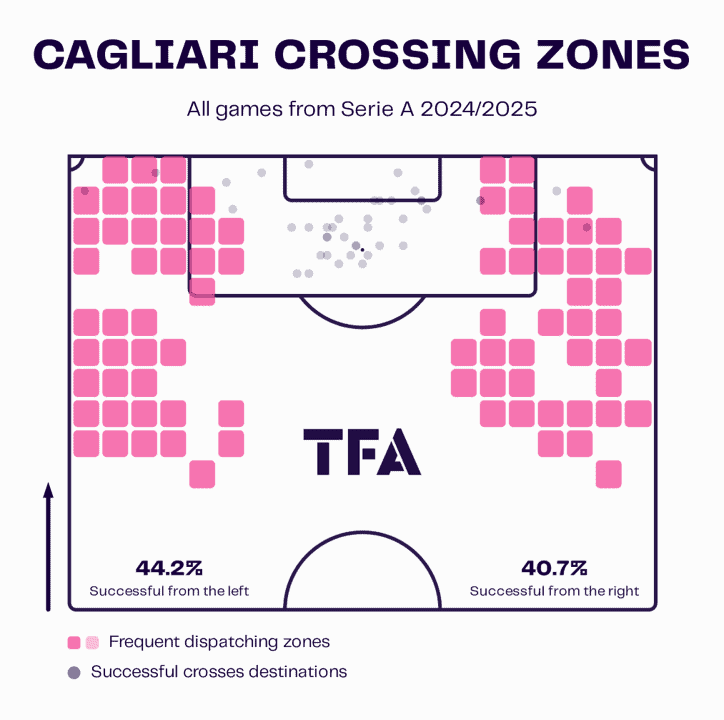
Crossing has been an important part of Cagliari’s tactics this season, but something needs to change.
Cagliari Shot Map – Serie A 2024/2025
With 16 headed shots so far (fourth-highest in Serie A), there is clearly an ability to win aerial duels in the box.
Cagliari also ranks second in Serie A for both crosses per 90 and cross accuracy, so while there is some potential in attacking this way, perhaps a small tweak somewhere could be made to maximise their impact from crosses and to get the goals flowing.
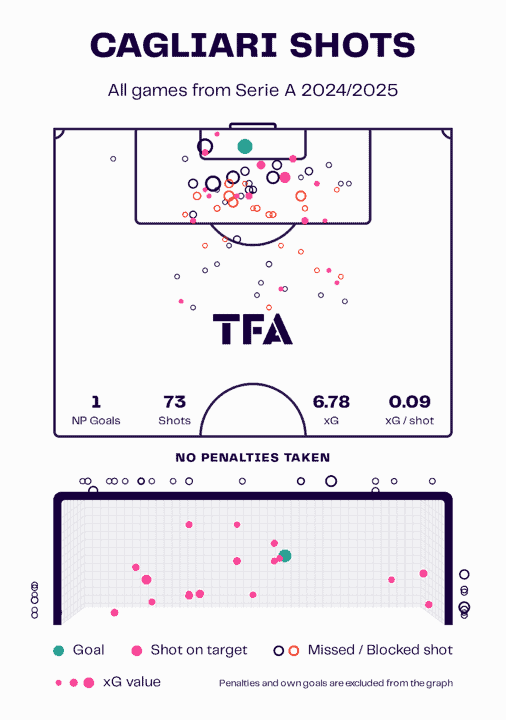
As we explained, Cagliari ranks third in Serie A for shot attempts this season.
However, they also rank bottom for shots on target, which is a clear problem that needs addressing.
The map above shows where Cagliari’s shots this season have come from.
The data tells us that they miss the target far too often inside the box—snatching at chances is a regular occurrence.
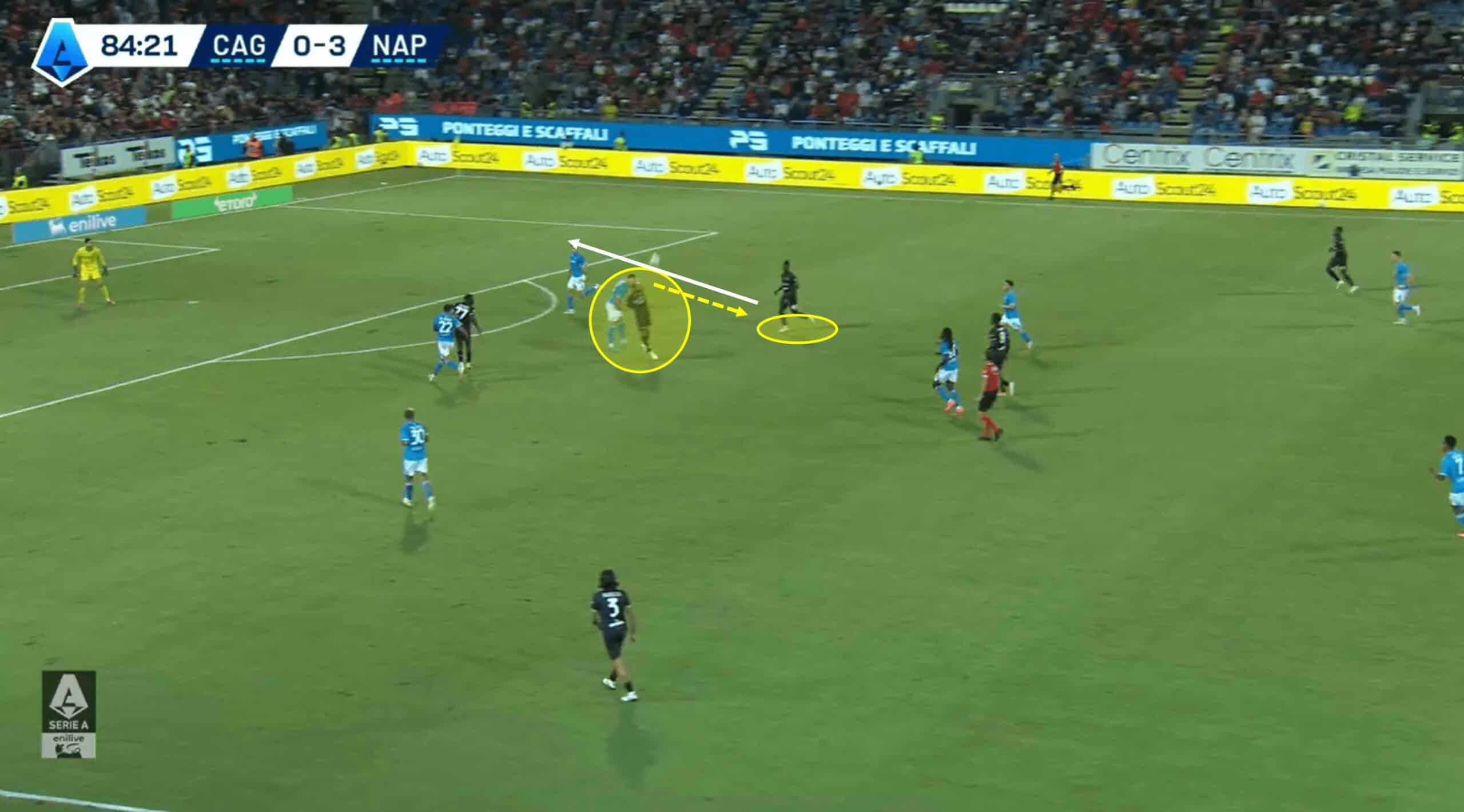
For as good as they can be in certain parts of their game, Cagliari can sometimes be their worst enemy.
Again, we’re talking about decision-making in key moments.
Figure 7 above demonstrates a lack of good decision-making.
Following a lofted ball into the attacking third, a well-cushioned header brings the ball down to Kingston Mutandwa.
He opts to attempt the most audacious first-time volley, which flies wildly high and wide, much to the frustration of his teammates.
This decision would’ve been understandable if Mutandwa had no other attacking options, but as you can see, he had some decent nearby support.
He also would’ve had the opportunity to engage in a 1v1 with the last Napoli defender.
Cagliari Off-The-Ball Aggression
More often than not, teams that are around the relegation zone tend to be more reserved in their defensive approach, but Cagliari are bucking that trend with an aggressive approach.
Cagliari High Regains Map – Serie A 2024/2025
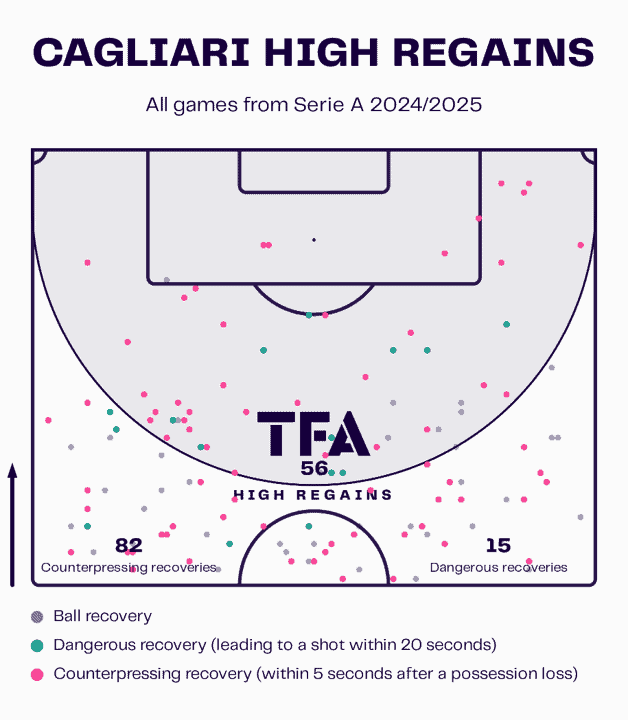
As Figure 8 above shows, they’re active in a variety of zones in the opposition half, including a good engagement in counter-pressing, which is no surprise.
With a PPDA of 8.92 (third-lowest in the league) and a challenge intensity of 6.2 (second-highest in Serie A), it is clear that Cagliari are sticking to their guns when it comes to defensive tactics.
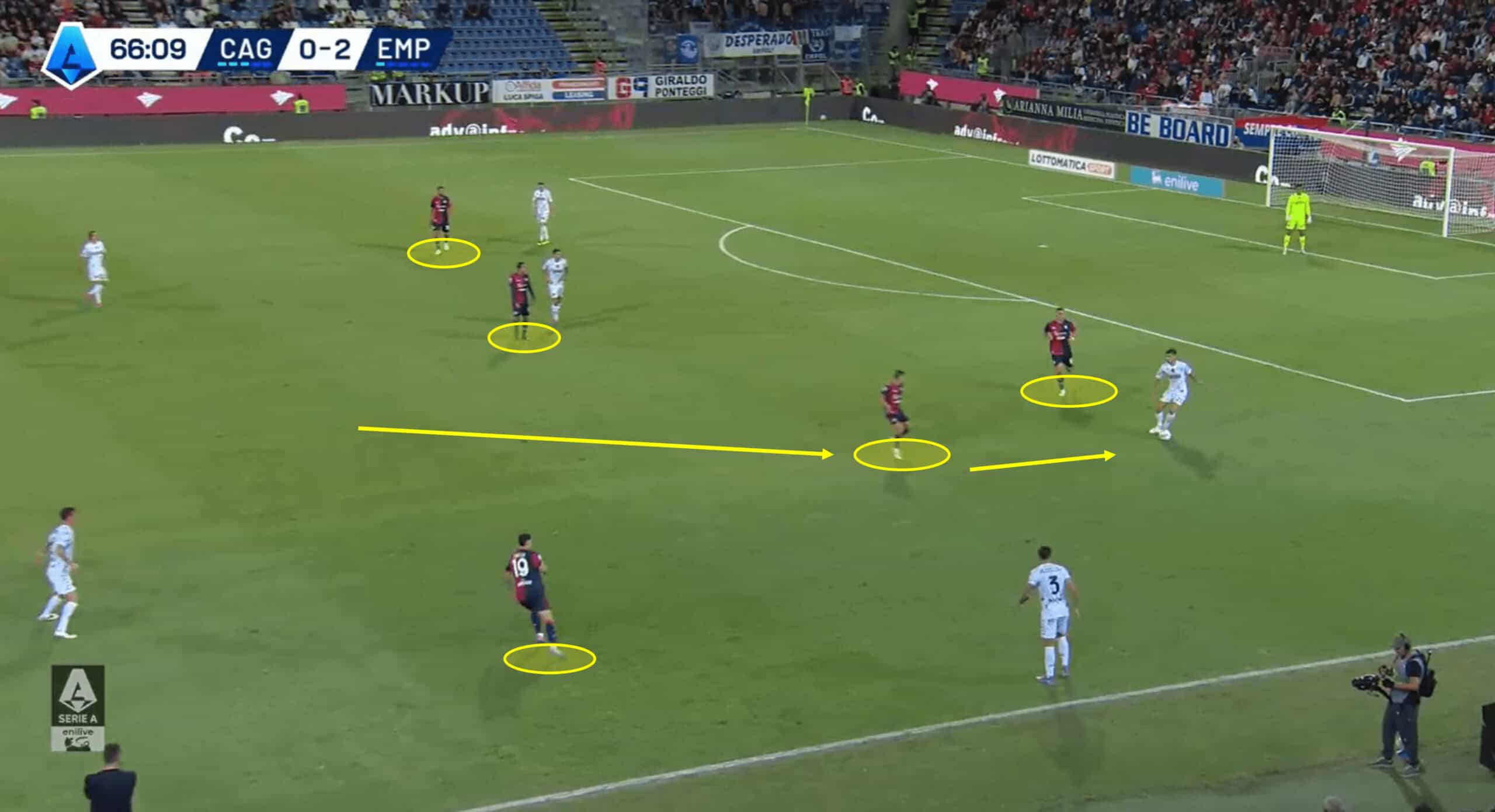
Yes, the example in Figure 9 comes after a failed Cagliari attack with Empoli looking to move possession forward quickly shortly after – but Cagliari’s response epitomises their tactics.
While they could’ve retreated into a mid/low block, they allowed their present players to remain high while marking passing options/lines and closing the ball down with solid intensity.
Deeper in midfield (which is out of shot in this example), the rest of the midfield unit, with select defenders, wait on standby, ready to engage with similar intensity and aggression if the opposition beats that initial press.
Conclusion
There is hope for Cagliari – in many attacking metrics, they are performing well.
It’s down to Davide Nicola to rally his team, raise the confidence and instil some composure and patience – perhaps the odd tactical tweak here or there, and the goals will soon start to flow.
Plenty of teams are performing worse than Cagliari in terms of defensive output, and Nicola’s high-pressing tactics off the ball could be vital in picking up points against teams that struggle against that kind of intensity.
However, they must insert that clinical edge into their game quickly.

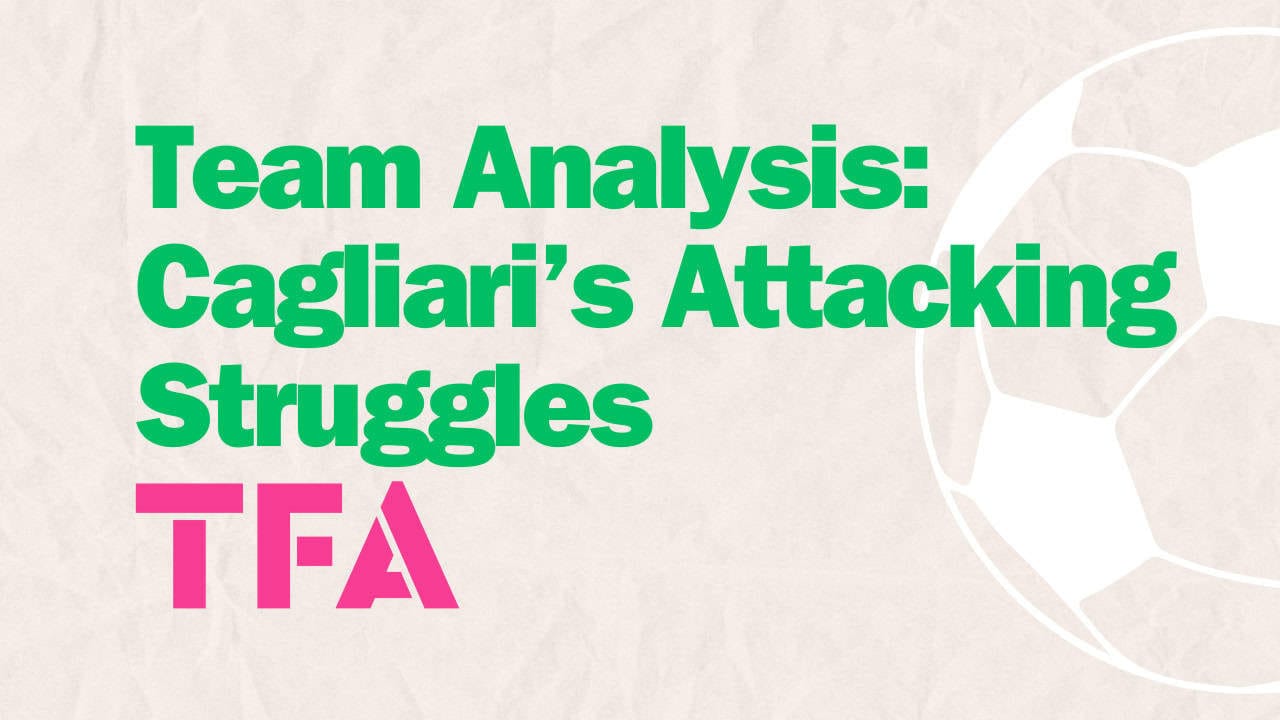




Comments